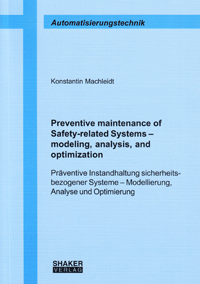
Shop : Details
Shop
Details

January 2016
Konstantin Machleidt
Preventive maintenance of Safety-related Systems – modeling, analysis, and optimization
Präventive Instandhaltung sicherheitsbezogener Systeme – Modellierung, Analyse und Optimierung
Safety-related Systems (SRS) protect from the unacceptable risk resulting from failures of technical systems. The average probability of dangerous failure on demand (PFD) of these SRS in low demand mode is limited by standards. Probabilistic models are applied to determine the average PFD and verify the specified limits. In this thesis an effective framework for probabilistic modeling of complex SRS is provided. This framework enables to compute the average, instantaneous, and maximum PFD. In SRS, preventive maintenance (PM) is essential to achieve an average PFD in compliance with specified limits. PM intends to reveal dangerous undetected failures and provides repair if necessary. The introduced framework pays special attention to the precise and detailed modeling of PM. Multiple so far neglected degrees of freedom of the PM are considered, such as two types of elementwise PM at arbitrarily variable times. As shown by analyses, these degrees of freedom have a significant impact on the average, instantaneous, and maximum PFD. The PM is optimized to improve the average or maximum PFD or both. A well-known heuristic nonlinear optimization method (Nelder-Mead method) is applied to minimize the average or maximum PFD or a weighted trade-off. A significant improvement of the objectives and an improved protection are achieved. These improvements are achieved via the available degrees of freedom of the PM and without additional effort. Moreover, a set of rules is presented to decide for a given SRS if significant improvements will be achieved by optimization of the PM. These rules are based on the well-known characteristics of the SRS. The presented rules aim to support the decision whether the optimization is advantageous for a given SRS and if it should be applied or not.
Keywords: Functional safety; safety-related systems; probabilistic modeling; preventive maintenance; probability of dangerous failure on demand
Available online documents for this title
You need Adobe Reader, to view these files. Here you will find a little help and information for downloading the PDF files.
Please note that the online documents cannot be printed or edited.
Please also see further information at: Help and Information.
Please also see further information at: Help and Information.
| Document |  | Document | ||
| Type |  | |||
| Costs |  | 36,60 € | ||
| Action |  | Purchase in obligation and download the file | ||
| Document |  | Table of contents | ||
| Type |  | |||
| Costs |  | free | ||
| Action |  | Download the file | ||
User settings for registered online customers (online documents)
You can change your address details here and access documents you have already ordered.
User
Not logged in
Export of bibliographic data
Shaker Verlag GmbH
Am Langen Graben 15a
52353 Düren
Germany
Am Langen Graben 15a
52353 Düren
Germany
Mon. - Thurs. 8:00 a.m. to 4:00 p.m.
Fri. 8:00 a.m. to 3:00 p.m.
Fri. 8:00 a.m. to 3:00 p.m.
Contact us. We will be happy to help you.

